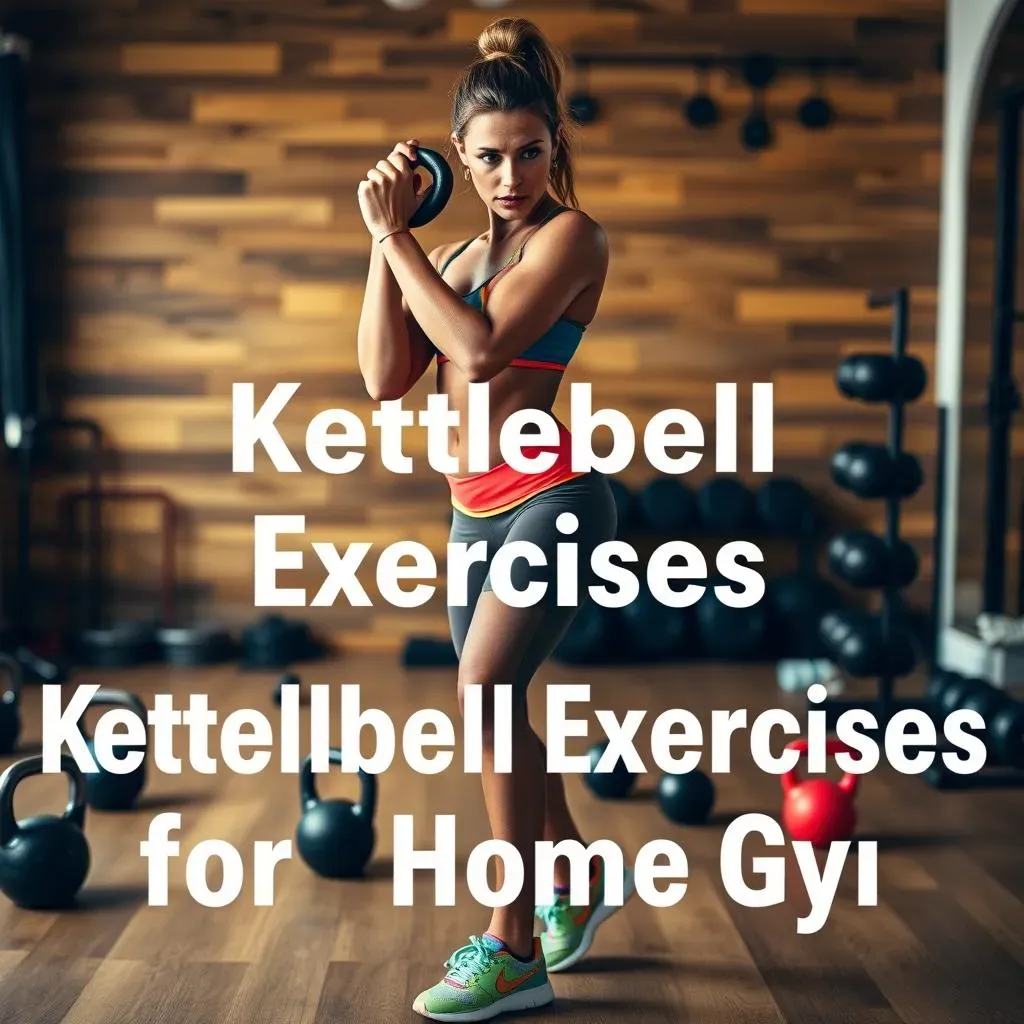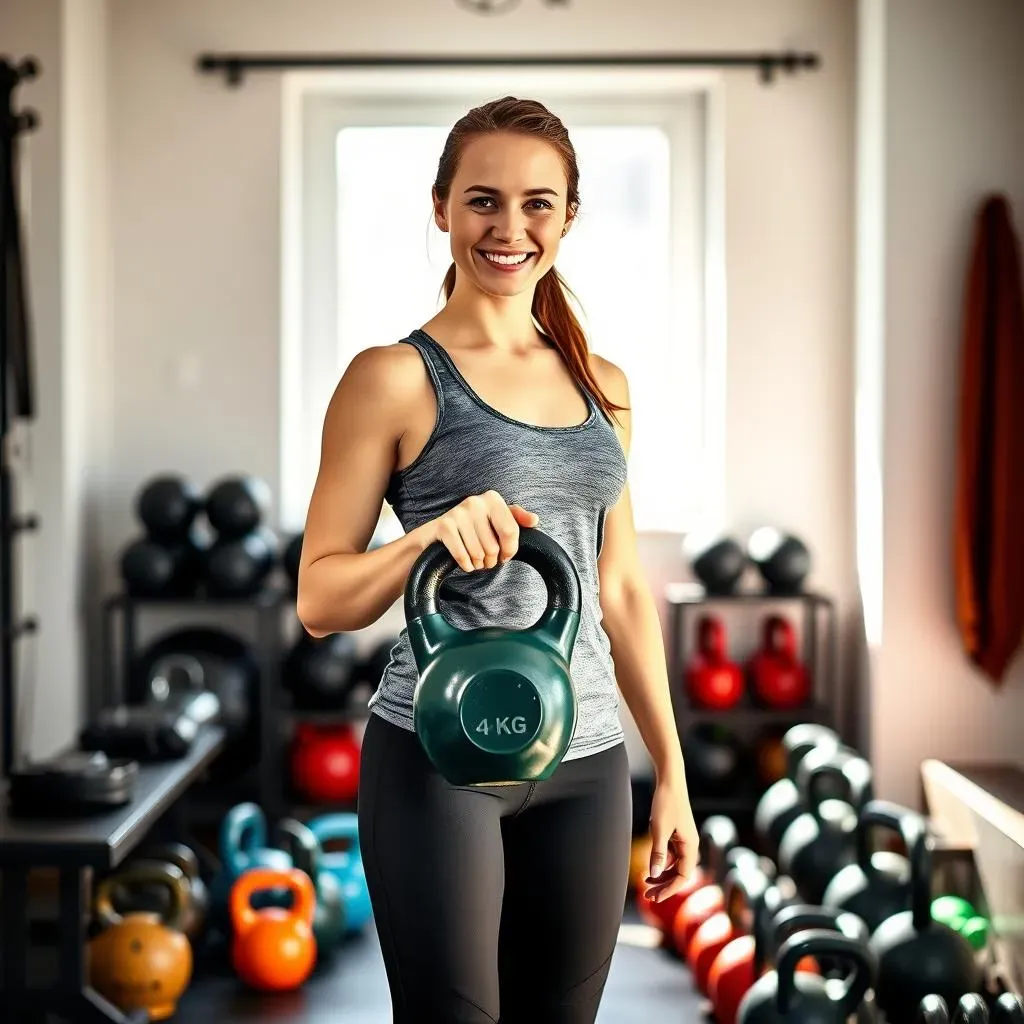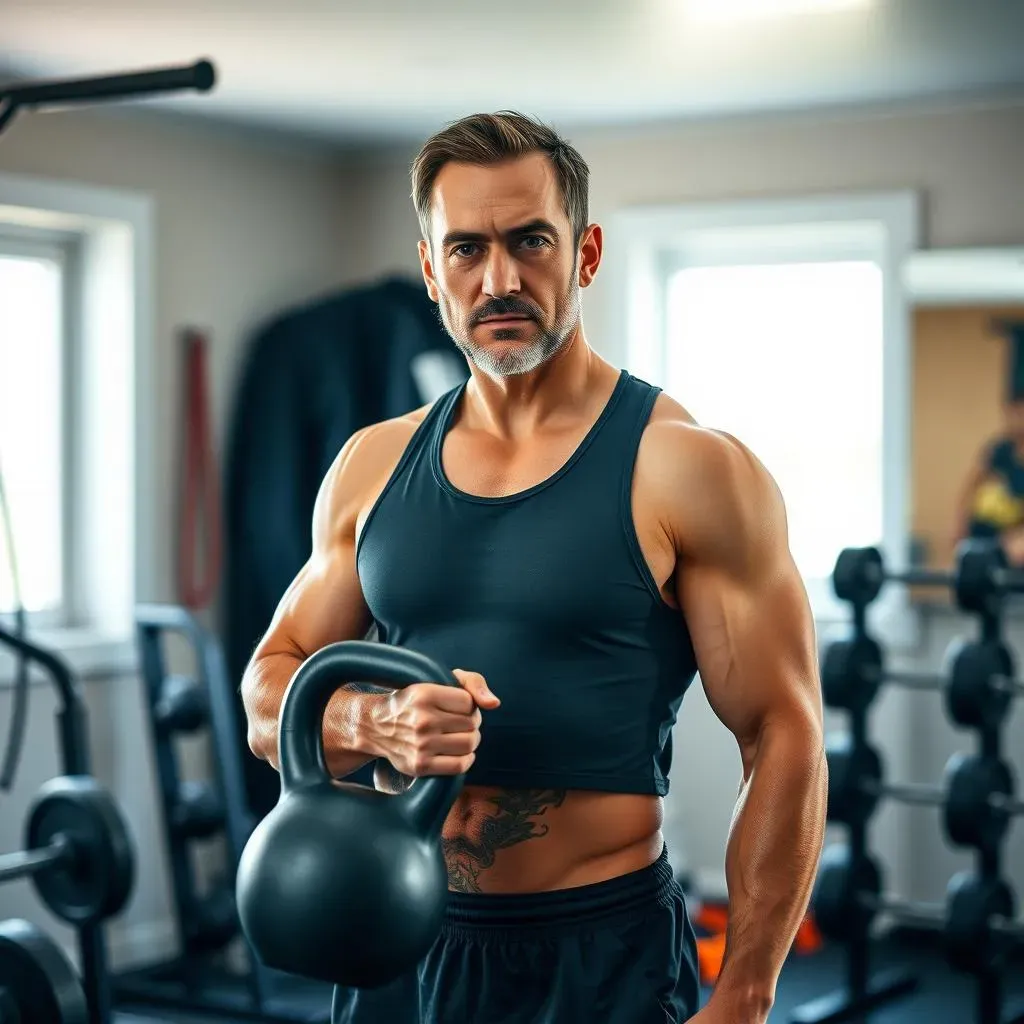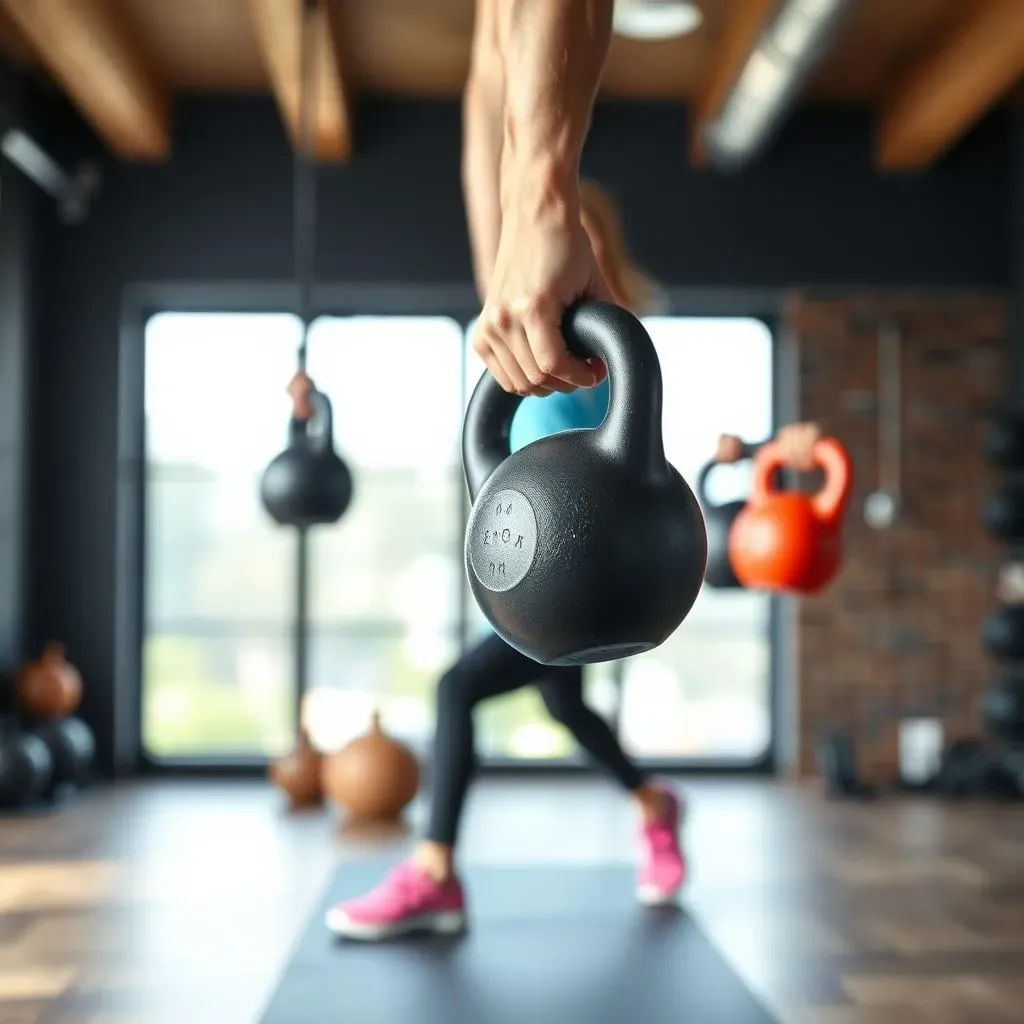Table of Contents
Tired of crowded gyms and expensive memberships? What if I told you that you could get a killer full-body workout right in your living room? That's where the magic of kettlebells comes in. These cannonball-shaped weights are not just another piece of home workout equipment; they're a versatile tool that can transform your fitness journey. This article will guide you through why kettlebells are a must-have for your home gym. I'll also show you some essential exercises to get you started, and help you choose the right kettlebell for your needs. We'll wrap up with how to build a complete routine using only these amazing weights. So, get ready to ditch the excuses and discover how home workout equipment with kettlebells can unlock your fitness potential. Let’s get moving!
Why Kettlebells are a Home Workout Equipment Game Changer

Why Kettlebells are a Home Workout Equipment Game Changer
Space-Saving Superstars
Let's be real, not everyone has the space for a full-blown gym at home. I get it; my apartment is tiny! That's where kettlebells shine. Unlike bulky machines or a whole rack of dumbbells, a single kettlebell can provide a complete workout. It’s like having a mini-gym that fits in a closet. Seriously, you can stash it under your bed, in a corner, or even use it as a quirky doorstop (though I wouldn't recommend that last one!). The best part? You don't need a ton of room to swing, lift, and get your sweat on. It’s the perfect home workout equipment for small spaces.
I remember when I first got into kettlebells, I was living in a cramped studio apartment. My only 'gym' was a tiny corner by the window. Yet, I could still do a full-body workout with just one kettlebell. It was a revelation! I went from feeling limited by my space to feeling empowered by the versatility of this single piece of equipment. It really changed the way I thought about home workouts.
The Ultimate Versatility
Forget about needing a different machine for every muscle group. Kettlebells are the Swiss Army knives of the fitness world. You can use them for strength training, cardio, and even flexibility work. Think swings for power, squats for your legs, presses for your upper body, and rows for your back. The list goes on! It's insane how many different exercises you can do with just one weight. This versatility means you're not just building strength; you're also improving your endurance and coordination. It's a total package deal, all from one piece of equipment.
My own experience with kettlebells has been nothing short of amazing. I've used them for everything from high-intensity interval training (HIIT) to slow, controlled strength work. One day, I'm doing a swing workout that gets my heart pumping, and the next, I'm focusing on deep, controlled squats. The adaptability of kettlebells means I never get bored, and my body is always challenged in new ways. It’s a game changer, I tell you!
Feature | Kettlebells | Traditional Gym Equipment |
|---|---|---|
Space Requirements | Minimal | Significant |
Versatility | High | Limited to Specific Exercises |
Cost | Relatively Low | High |
Essential Kettlebell Exercises for Your Home Gym

Essential Kettlebell Exercises for Your Home Gym
The Mighty Swing
Let's kick things off with the kettlebell swing, the king of all kettlebell exercises. This isn't just about lifting a weight; it's a full-body power move that works your glutes, hamstrings, core, and even your shoulders. Picture this: you're hinging at your hips, not squatting, and using that power to drive the kettlebell up. It's like a pendulum motion, and when you get it right, you'll feel like a total boss. I remember struggling with swings at first, feeling like I was going to launch the kettlebell into the ceiling. But once you get the hang of it, it’s an amazing exercise.
The swing is fantastic because it’s not just about strength; it’s about explosiveness and coordination. It really gets your heart pumping too. It’s like a full-body cardio session disguised as strength training. Plus, it's a fantastic way to build a strong posterior chain, which is crucial for overall fitness and injury prevention.
The Goblet Squat
Next up, we've got the goblet squat, a fantastic way to build lower body strength and improve your squat form. Holding the kettlebell close to your chest, you’ll squat down as if you’re sitting in a chair. This exercise not only works your quads and glutes but also engages your core to maintain stability. The beauty of the goblet squat is that it helps you maintain a proper upright posture, which is super important for anyone who spends a lot of time sitting. It's a great alternative if you find standard squats a bit tricky to get right.
I love goblet squats because they're a great way to warm up before a workout, or as a standalone exercise. It’s an exercise that is accessible to all levels. I’ve found that using a kettlebell for squats really helps me to get a deeper, more controlled movement. It’s like having a personal trainer guiding you to a better squat!
Exercise | Primary Muscles Worked | Benefits |
|---|---|---|
Kettlebell Swing | Glutes, Hamstrings, Core | Power, Cardio, Posterior Chain Strength |
Goblet Squat | Quads, Glutes, Core | Lower Body Strength, Improved Squat Form, Stability |
The Turkish Get-Up
Now, let's talk about the Turkish Get-Up, or TGU as it’s often called. This is a more complex movement, but trust me, it’s worth learning. It’s not just about strength; it’s about coordination, mobility, and full-body control. You start lying on the floor with the kettlebell held overhead, and you slowly rise to a standing position, using a series of controlled movements. It’s like a slow-motion dance that challenges every single muscle in your body. I know when I first tried it, I felt like a newborn giraffe trying to walk. But with practice, it becomes smoother, and you feel incredibly accomplished after completing it.
The TGU is amazing because it’s a full-body workout in a single movement. It improves your stability, core strength, and shoulder health. It also forces you to be very aware of your body position and control. It's a great exercise to add to your routine if you’re looking for a challenge that will make you feel like a true athlete. It’s like the ultimate test of your fitness and coordination. It might seem intimidating at first, but it’s incredibly rewarding once you master it.
Choosing the Right Kettlebell Home Workout Equipment

Choosing the Right Kettlebell Home Workout Equipment
Okay, so you're ready to jump into the world of kettlebells, that’s awesome! But hold up, before you grab the first one you see, let's talk about picking the right weight. It’s not about going as heavy as possible right away, it’s about finding a weight that challenges you while still letting you maintain good form. If you go too heavy, you're risking injury and bad habits. It's like trying to run a marathon without training; it’s just not going to end well. So, how do you choose? Well, for most beginners, I usually recommend starting with a weight between 8-12 kg (18-26 lbs) for women and 12-16 kg (26-35 lbs) for men. If you’re already pretty active, you might go a bit heavier, but the key is to start light and focus on getting the movements down.
I remember when I first started, I thought I was super strong and grabbed a 20kg bell. Big mistake! I could barely do a few swings without feeling like my back was going to give out. I quickly realized that it’s way better to start with a lighter weight and nail the technique, then gradually increase. It's all about listening to your body and not trying to be a hero on day one. Trust me, your body will thank you for it!
Fitness Level | Recommended Kettlebell Weight (Women) | Recommended Kettlebell Weight (Men) |
|---|---|---|
Beginner | 8-12 kg (18-26 lbs) | 12-16 kg (26-35 lbs) |
Intermediate | 12-16 kg (26-35 lbs) | 16-24 kg (35-53 lbs) |
Advanced | 16+ kg (35+ lbs) | 24+ kg (53+ lbs) |
Beyond weight, you also need to think about the type of kettlebell. There are two main kinds: cast iron and competition. Cast iron kettlebells are the most common, they're durable and usually cheaper. They’re great for most people. Competition kettlebells, on the other hand, are always the same size, regardless of weight. This can be useful if you’re planning to do more advanced training. They’re also more expensive. Honestly, for most home workouts, a regular cast iron kettlebell is perfect. It's like choosing between a regular car and a race car; both get you where you need to go, but one is a bit fancier and pricier.
Also, check the handle! You want a handle that is smooth, not too thick, and not too thin. It should be comfortable to grip, even when your hands get sweaty. I’ve had kettlebells where the handle was too rough, and it was like trying to do a workout with sandpaper. Not fun! So, before you buy, make sure it feels good in your hands. It really makes a difference in your workout experience. It's like finding the perfect pair of shoes; they need to fit right for you to perform your best.
Building a Full Body Routine With Kettlebells at Home

Building a Full Body Routine With Kettlebells at Home
Crafting Your Weekly Plan
Alright, so you've got your kettlebell and you're itching to get started. Now, let's talk about crafting a weekly plan. It's not about smashing yourself every single day. That's a recipe for burnout and injury. Instead, let's aim for a balanced approach. I’d recommend starting with 2-3 workouts per week, with rest days in between. This gives your muscles time to recover and rebuild. Think of it like this: you wouldn’t run a marathon every day, would you? Your body needs time to recharge. I like to mix things up, doing a full-body workout one day, focusing on strength the next, and then maybe throwing in some cardio.
When creating your plan, think about the exercises we’ve already discussed. Include swings, goblet squats, and maybe even try the Turkish get-up if you're feeling adventurous. It's also a good idea to incorporate some other movements like rows, presses, and lunges. The key is to vary your exercises to work different muscle groups and avoid overuse injuries. Start with 3 sets of 8-12 reps for most exercises and adjust as you get stronger. It’s all about finding what works best for you, and that might take some trial and error. The most important thing is to be consistent and listen to your body. Don't be afraid to tweak your plan as you go. Your body will tell you what it needs!
Sample Weekly Schedule
To give you a better idea, let’s look at a sample weekly schedule. Remember, this is just a suggestion; feel free to adjust it to fit your needs and preferences. On Monday, you could do a full-body workout with swings, goblet squats, rows, and presses. Wednesday could be your strength day, focusing on heavier weights with fewer reps, maybe some lunges and Turkish get-ups. Friday could be a lighter day with some cardio and core work, using the kettlebell for some light swings and planks. Don't forget to include a warm-up before each session and a cool-down afterward. I like to do some light cardio, like jumping jacks or high knees, and a few dynamic stretches before, and static stretches after.
Remember, rest days are just as important as workout days. Use them to recover, stretch, or do some light activity like walking. The goal is to create a sustainable routine that you can stick with over time. It’s not a sprint, it’s a marathon. Don't push yourself too hard at the beginning. It's much better to start slow and build up gradually. Over time, you’ll find yourself getting stronger and more comfortable with the exercises. I’ve been working out with kettlebells for years, and I still learn new things and tweak my routine. It’s an ongoing journey, not a destination!
Day | Workout Focus | Exercises |
|---|---|---|
Monday | Full Body | Swings, Goblet Squats, Rows, Presses |
Wednesday | Strength | Lunges, Turkish Get-ups, Heavier Weights |
Friday | Cardio & Core | Light Swings, Planks, Core Exercises |
Rest Days | Active Recovery | Light Walking, Stretching |
